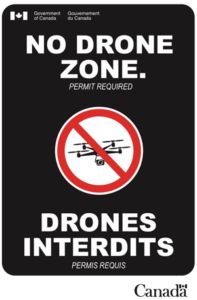Transport Canada has announced the launch of a new incident-reporting tool "to keep Canadians safe from reckless drone use."
The new online reporting tool will allow people to report drone "incidents" from their mobile phones and will help Transport Canada "gather valuable information that will assist inspectors with investigations." It serves as a single-entry-point for drone incident reporting but is not intended to replace the existing official aviation incident reporting systems, such as the Civil Aviation Daily Occurrence Reporting System (CADORS).
Along with basic information such as date and location of the incident, the online form asks the following questions:
- Was the drone flying near an aircraft?
- Was the drone flying at a high altitude?
- Was the drone flying close to an airport/aerodrome (helipad, heliport, seaplane base, etc.)? and
- Did the drone fly close to or over the following zones? (such as a populated area; home/private property; crowd (sporting event, concert, festival); forest fire; moving vehicles, highways, busy streets, bridges, etc.)
Complaints are also asked to provide a description of the drone (helpful drone silhouettes are provided) and a description of the operator. The form also asks the complainant whether they have "gathered evidence" such as photos or video. Complainants have the option of reporting anonymously.
In the last twelve months, Transport Canada has increased its scrutiny and supervision of drones (also known as unmanned air vehicles (UAVs)) and, according to its backgrounder on the issue, has focused on a number of key areas, including:
Revising and/or increasing regulations for drone operators: In spring 2017, Transport Canada will publish proposed regulations in Canada Gazette, Part I, for small drones (25 kilograms or less) that are operated within visual line-of-sight. This category of drone was previously exempt from specific regulation. Transport Canada has said that the proposed changes will introduce more flexible and clear rules for all drone operators. The public will have the opportunity to comment on the proposed regulations before they come into force. Proposed changes include:
- new flight rules
- aircraft marking and registration requirements
- knowledge testing
- minimum age limits
- pilot permits for certain UAV operations
Simplifying rules for commercial operators with two new exemptions: Commercial and research drones were already subject to regulations, but Transport Canada will issue two new UAV exemptions for non-recreational operators that will replace the existing exemptions, which expired on December 21, 2016. These new exemptions will allow UAV operators flying for work or research to conduct lower-risk operations without having to apply for a Special Flight Operations Certificate (SFOC). The new exemptions will allow operators to fly closer to built-up areas and smaller aerodromes as long as they comply with strict safety conditions and notify Transport Canada before flying. Detailed information regarding the new exemptions will be available on TC's drone safety webpage when the exemptions come into effect on December 22, 2016;
Announcing a new commercial drone test site in Alberta: On November 3, 2016, the Minister announced that the Village of Foremost, Alberta together with the Canadian Centre for Unmanned Vehicle Systems (CCUVS) in Lethbridge, Alberta had established the Foremost Centre for Unmanned Systems based out of the Foremost Aerodrome. The site will support research and development and provide the industry with dedicated, restricted airspace where they can test UAVs beyond visual line of sight;
Partnering with retailers to provide safety information at the point-of-sale: Participating manufacturers have agreed to include a Transport Canada safety card with every drone they sell. Participating retailers have agreed to provide a link to the department's drone safety webpage on their respective websites; and
Launching a "No Drone Zone" public awareness campaign: In June, 2016 the Ministry launched a No Drone Zone public awareness campaign that focused on partnering with airports and other organizations to educate Canadians about drone safety. Transport Canada also introduced "No Drone Zone" signs and has worked with 20 organizations to install over 100 of these signs in and around airports, the backgrounder said.

According to Transport Canada, anyone who operates a drone in a reckless and negligent manner, violates controlled or restricted airspace, or endangers the safety of manned aircraft could face fines of up to $25,000 and/or jail time. If an operator does not follow the requirements of their SFOC, Transport Canada can issue fines of up to $3,000 for an individual and $15,000 for a business.
To view original article, please click here.
The content of this article is intended to provide a general guide to the subject matter. Specialist advice should be sought about your specific circumstances.


